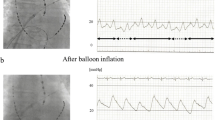Abstract
Purpose
Pressure waveform analysis has the potential for facilitated assessment of pulmonary vein occlusion during cryoballoon ablation for atrial fibrillation. Data on clinical outcomes using this method are lacking. We sought to validate through clinical outcomes the use of pressure waveform analysis as the primary method of determining pulmonary vein occlusion during cryoballoon ablation.
Methods
A study was performed of 122 consecutive patients with atrial fibrillation (85% paroxysmal) undergoing cryoballoon ablation from May 2014 through July 2015 at a single institution using pressure waveform analysis as the primary method of assessing pulmonary vein occlusion.
Results
Cryoballoon ablation, with additional segmental radiofrequency ablation in 13.7%, resulted in complete pulmonary vein isolation in 100% of patients. The single procedure freedom from recurrence of atrial arrhythmia beyond the initial 3-month post-ablation was 81.2% at a mean follow-up of 237 days. Recurrence of atrial arrhythmia within 3-month post-ablation was 11.1%, and predicted recurrence beyond 3 months. Repeat ablation was performed in 12.0% of patients.
Conclusions
In the largest study to date on this topic and the only study to focus on clinical outcomes, pressure waveform analysis as the primary method of determining pulmonary vein occlusion in cryoballoon ablation of atrial fibrillation resulted in acute and long-term procedural success rates comparable to those reported with use of routine pulmonary venography. Controlled study is needed to confirm these findings and to determine if this technique affects variables such as procedure duration and radiation exposure.


Similar content being viewed by others
References
Packer DL, Kowal RC, Wheelan KR, Irwin JM, Champagne J, Guerra PG, et al. Cryoballoon ablation of pulmonary veins for paroxysmal atrial fibrillation. J Am Coll Cardiol. 2013;61(16):1713–23.
Giovanni GD, Wauters K, Chierchia G-B, Sieira J, Levinstein M, Conte G, et al. One-year follow-up after single procedure cryoballoon ablation: a comparison between the first and second generation balloon. J Cardiovasc Elect. 2014;25(8):834–9.
FüRnkranz A, Bordignon S, Dugo D, Perotta L, Gunawardene M, Schulte-Hahn B, et al. Improved 1-year clinical success rate of pulmonary vein isolation with the second-generation cryoballoon in patients with paroxysmal atrial fibrillation: improved efficacy of second-generation cryoballoon. J Cardiovasc Elect. 2014;25(8):840–4.
Metzner A, Reissmann B, Rausch P, Mathew S, Wohlmuth P, Tilz R, et al. One-year clinical outcome after pulmonary vein isolation using the second-generation 28-mm cryoballoon. Circ Arrhyth Electrophysiol. 2014;7(2):288–92.
Chierchia G-B, Di Giovanni G, Ciconte G, de Asmundis C, Conte G, Sieira-Moret J, et al. Second-generation cryoballoon ablation for paroxysmal atrial fibrillation: 1-year follow-up. Europace. 2014;16(5):639–44.
Kosmidou I, Wooden S, Jones B, Deering T, Wickliffe A, Dan D. Direct pressure monitoring accurately predicts pulmonary vein occlusion during cryoballoon ablation. J Vis Exp. 2013; doi:10.3791/50247.
Ciconte G, de Asmundis C, Sieira J, Conte G, Di Giovanni G, Mugnai G, et al. Single 3-minute freeze for second-generation cryoballoon ablation: one-year follow-up after pulmonary vein isolation. Heart Rhythm. 2015;12(4):673–80.
Miyazaki S, Hachiya H, Nakamura H, Taniguchi H, Takagi T, Hirao K, et al. Pulmonary vein isolation using a second-generation cryoballoon in patients with paroxysmal atrial fibrillation: one-year outcome using a single big-balloon 3-minute freeze technique: cryoballoon ablation of PAF. J Cardiovasc Elect. 2016; doi:10.1111/jce.13078.
Aryana A, Singh SM, Kowalski M, Pujara DK, Cohen AI, Singh SK, et al. Acute and long-term outcomes of catheter ablation of atrial fibrillation using the second-generation cryoballoon versus open-irrigated radiofrequency: a multicenter experience: second-generation cryoballoon versus RF. J Cardiovasc Elect. 2015;26(8):832–9.
Kardos A, Kis Z, Som Z, Nagy Z, Foldesi C. Two-year follow-up after contact force sensing radiofrequency catheter and second-generation cryoballoon ablation for paroxysmal atrial fibrillation: a comparative single centre study. Biomed Res Int. 2016; doi:10.1155/2016/6495753.
Su W, Kowal R, Kowalski M, Metzner A, Svinarich JT, Wheelan K, et al. Best practice guide for cryoballoon ablation in atrial fibrillation: the compilation experience of more than 3000 procedures. Heart Rhythm. 2015;12(7):1658–66.
SiklóDy CH, Minners J, Allgeier M, Allgeier H-J, Jander N, Keyl C, et al. Pressure-guided cryoballoon isolation of the pulmonary veins for the treatment of paroxysmal atrial fibrillation. J Cardiovasc Elect. 2010;21(2):120–5.
Safavi-Naeini P, Shanoon F, Nazeri A, Rasekh A, Saeed M, Razavi M, et al. Cryoballoon pressure waveform change during balloon inflation is not a reliable predictor of adequate pulmonary vein occlusion. Pacing Clin Electrophysiol. 2014;37(12):1702–7.
Kühne M, Schaer B, Ammann P, Suter Y, Osswald S, Sticherling C. Cryoballoon ablation for pulmonary vein isolation in patients with paroxysmal atrial fibrillation. Swiss Med Wkly. 2010;140(15–16):214–21.
Wasserlauf J, Pelchovitz DJ, Rhyner J, Verma N, Bohn M, Li Z, et al. Cryoballoon versus radiofrequency catheter ablation for paroxysmal atrial fibrillation: cryoballoon versus radiofrequency ablation. Pacing Clin Electrophysiol. 2015;38(4):483–9.
Author information
Authors and Affiliations
Corresponding author
Ethics declarations
The Institutional Review Board at this hospital approved the study protocol.
Conflict of interest
The authors declare that they have no conflict of interest.
Funding sources
This research did not receive any specific grant from funding agencies in the public, commercial, or not-for-profit sectors.
Ethical approval
All procedures performed in studies involving human participants were in accordance with the ethical standards of the institutional and/or national research committee and with the 1964 Helsinki Declaration and its later amendments or comparable ethical standards. This article does not contain any studies with animals performed by any of the authors.
Informed consent
Informed consent was obtained according to institutional standards for the clinically indicated procedures the patients included in this retrospective study underwent. For this type of study, formal consent for the study itself is not required.
Rights and permissions
About this article
Cite this article
Sharma, A., Dhoot, J., Wang, J. et al. Outcomes following cryoballoon ablation for atrial fibrillation guided by pressure waveform monitoring without the routine use of pulmonary venography. J Interv Card Electrophysiol 49, 75–82 (2017). https://doi.org/10.1007/s10840-017-0249-3
Received:
Accepted:
Published:
Issue Date:
DOI: https://doi.org/10.1007/s10840-017-0249-3




